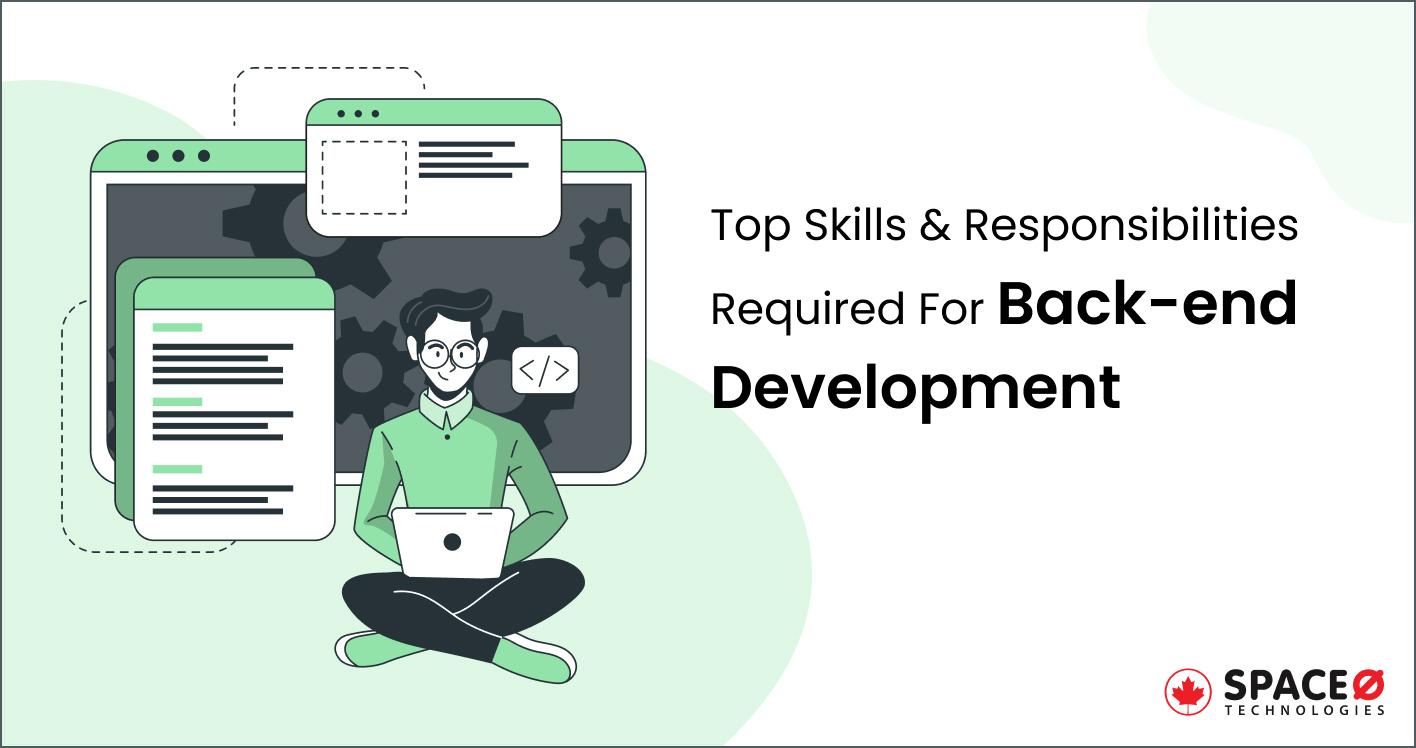
A Detailed Guide on What is Back End Development [2026 Updated]
Key Takeaways:
- Backend development implicates creating and managing the server side of applications that focuses on functionality, data storage, and server communication.
- Backend developers are responsible to create the backend of the website and have skills such as database management, API development, and server-side programming.
- Backend developers have distinct roles from front-end developers, focusing on the underlying functionality and logic of applications rather than the user interface.
There are about 1 billion websites – live on the internet. (Siteefy).
Now that’s huge. To operate such websites, there needs to be a mechanism to keep everything sailing smoothly, right? Well, that’s exactly what is Back End Development does.
While what we, end-users, see visually on the websites – essentially all that accounts for user experience and that all related to Front-End Development. Backend Development is what keeps the websites and web application running smoothly behind the scenes.
This article will discuss everything about Back-End development, the languages and technology involved in back-end development, the skills required by back-end developers, and front end vs back-end web development.
Table of Contents
What is Backend Development?
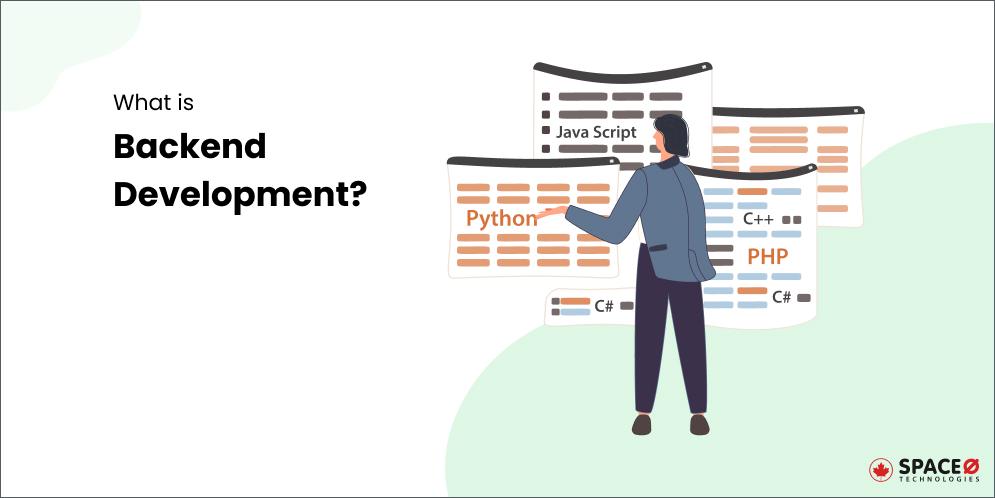
As discussed earlier, there are gazillion websites on the internet, and for them to work effectively, we need backend development tools.
You see, when you access any website, it involves communication between servers, applications, and databases. The backend code works as a communication agent between the servers, applications, and databases.
For example, you are reading this particular article right now on our website. Currently, whatever you are reading and seeing with your eyes – all the user experiences – the font, images, and text is related to the front end development.
On the other hand, this article’s content is being rendered from a server and fetched from a database. This rendering and fetching of data are all related to backend development.
Backend is, thus, related to server-side development and involves all the behind-the-scenes processes whenever you are doing an activity on a website.
It is the code that makes a website work. This code essentially acts as a communication medium between the database and browser for the exchange of information.
Back-End Development Tools & Technology
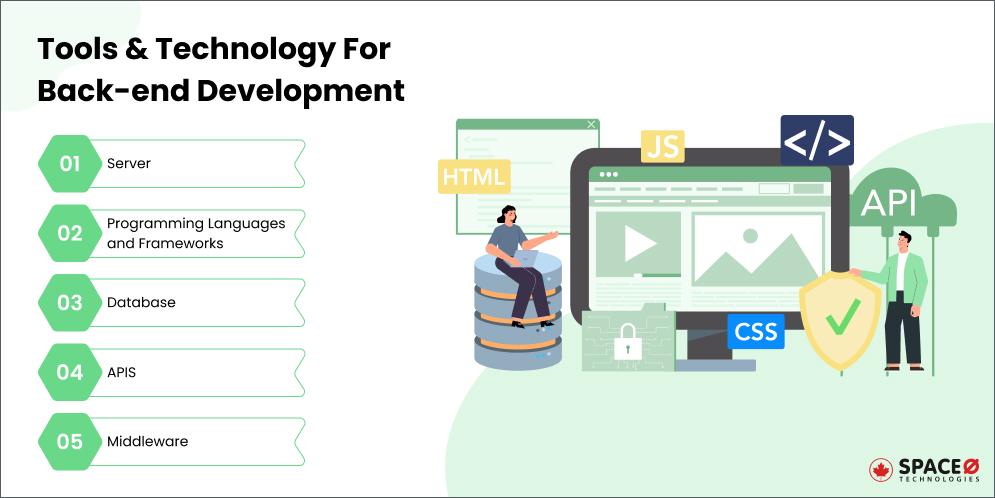
Now that we understand what backend web development is, it is time to dive into the technology and tools involved in backend development.
Backend, in essence, is all about the effective exchange of information between the server, database, and browser.
Unlike front-end development, which is mostly based on HTML, CSS, and JavaScript, back end web development has a lot of aspects to it, and we will discuss them one-by-one.
Server
The server is one of the most important components of backend web development.
Servers are high-powered computers and provide some shared resources that are essential for any network to function.
These resources are file storage, security, encryption, databases, and email.
So without a server, you won’t be able to access any data that is stored on the databases.
- You type the address of a website in the URL box of your browser and hit enter.
- The URL is broken down into parts, this helps in specifying the address.
- It is further translated into an IP address.
- The IP address gives the server an exact location to look at the data entered in the URL.
Database
The database is truly a website’s brain. It is the place where all the data or content of a website is stored. So the database is what makes a website dynamic.
For example, whenever you search for something on a website, you are essentially asking the website to go to its database and see if what you have searched for is present in the database.
The client-side or end-user of websites can also add/change information on a database by interacting with it. This generally happens in the case where users are allowed to upload data on the website.
For example, if you upload a photo on your Instagram, you are essentially updating the data on Instagram’s database. Now, if someone will search your profile on Instagram, they will also see the new photo that you uploaded, and that is because you have added new data to the database of Instagram.
Middleware
Middleware is the server-side software that helps to connect both frontend and backend development together of a website/application. It is a communication medium between the server and the website/application.
It can be multi-layered or organized into different layers of a website. This is where APIs come into play. APIs act as a bridge between the business and presentation layers, which ultimately helps make a website more efficient.
One of the examples of server-side middleware is Koa.js which is a server-side Javascript framework.
Programming Languages and Frameworks
Programming languages are a crucial component of back-end development.
There are a lot of options for backend developers to choose from when it comes to back end development languages. It largely depends on the type of website/application that you are working on.
Now, some programming languages are better than others based on the ease of typing codes and compatibility. There are Object-Oriented, compiled, or interpreted programming languages. So there’s a lot of variety in there.
PHP is one of the most commonly used server-side scripting languages, and a lot of websites are built on PHP. Then there’s Python that has exceptional processing power. There is lightweight backend language like Ruby as well that you might want to use.
Some of the other great backend development languages for developers are –
- Java
- C# and C++
- .NET
- Perl
- Node.js
- Scala
Combine these server-side programming languages with respective frameworks, and you can do efficient work in the field of backend development.
Some of the popular and commonly used backend frameworks are:
- Spring Framework (for Java)
- Symfony (for PHP)
- Django (for Python)
- Node.js including MeteorJS and ExpressJS (for JavaScript with Node.js)
- Ruby on Rails
- JSF (Java Server Faces)
Application Programming Interfaces (APIs)
APIs are another important aspect of backend web development nowadays. API or Application Programming Interfaces connect the software, websites/applications, databases, and services seamlessly.
They play an integral role in the building of server-side software. Oftentimes APIs replace complicated programming, which allows the software to communicate, making data transfer effortless.
Want to Hire Experienced Back-end Developers?
We are a leading software development company in Canada. Share your requirements with us and let’s get started.

7 Popular Back End Programming Languages
Here, we’ll discuss the 7 popular backend programming languages that are preferable for developing the backend of the application.
Java
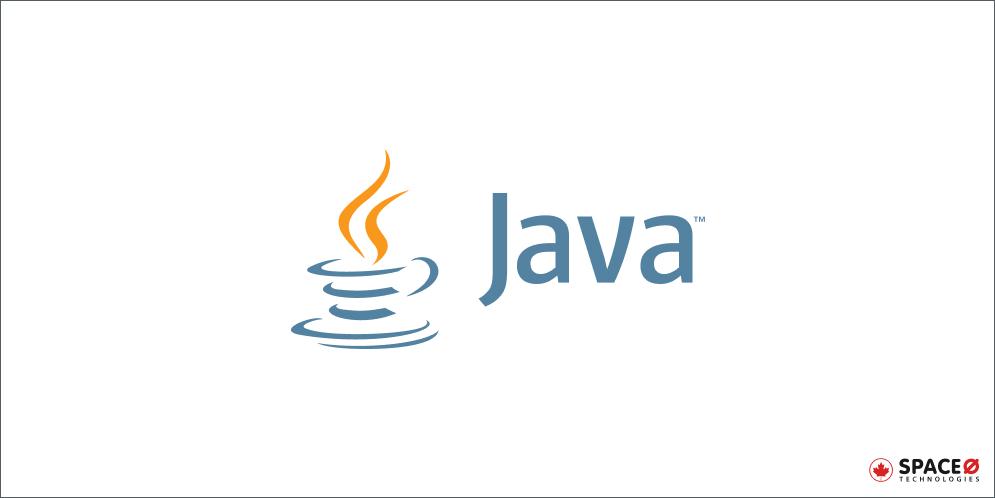
- Java is one of the most popular back-end web development languages and the reason for that is its versatile nature.
- Java has the Java Virtual Machine(JVM). This JVM functions as a middle layer and runs code on any computer regardless of where the code is compiled.
- Java is widely popular with business software developers and desktop software developers. It can be used for website development, networking, database connectivity.
- Some of the most popular companies that use Java are LinkedIn, eBay, and Pinterest.
Python
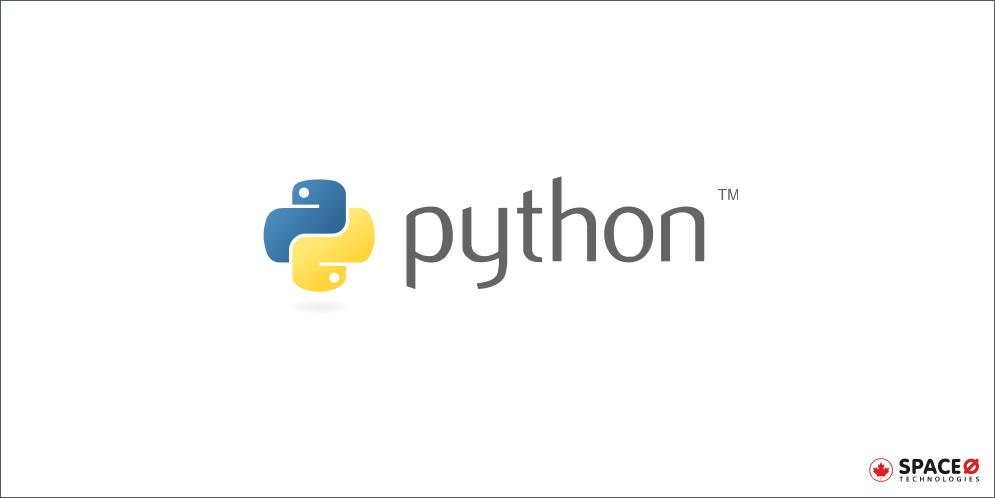
- Unlike Java, Python is one of the most beginner-friendly development languages. It is one of the most growing programming/ development languages in the world.
- Python is a dynamic, open-source object-oriented programming language.
- It is highly versatile and can be used for both web development and desktop development.
- The syntax in Python is simple and easy to learn, and there are fewer chances of getting errors on your code.
- It is great for simple web development.
- Some of the most popular companies that use Python are Netflix, Uber, and Spotify.
PHP
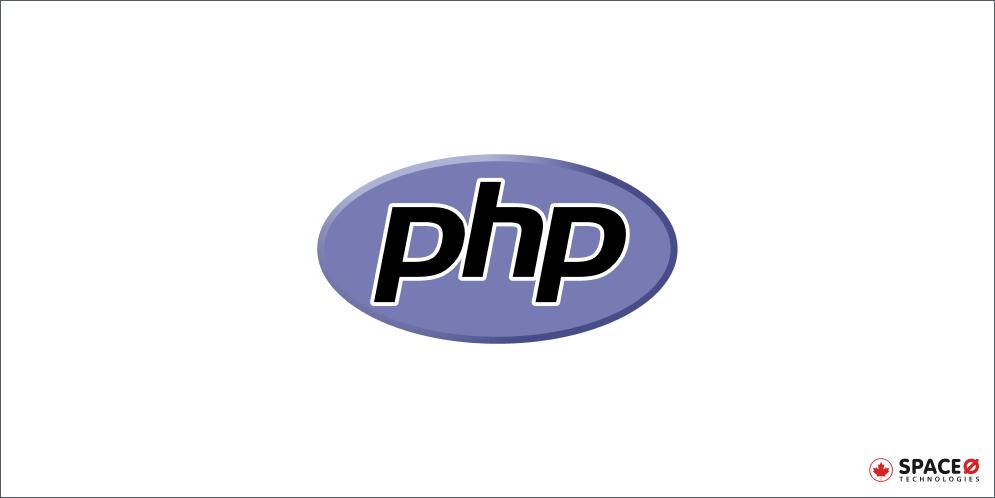
Almost 79.1% of the websites are powered by PHP on the server-side(W3Techs).
- It is a dynamic coding language and was released in 1955.
- With dynamic typing, you can have a bunch of solutions for a problem.
- There is less probability of errors while coding PHP.
- With PHP, you can make dynamic page content, send and receive cookies, and do a lot more.
- Some of the most popular companies that use PHP web development are Facebook, Mint, and Viber.
.NET(C#, VB)
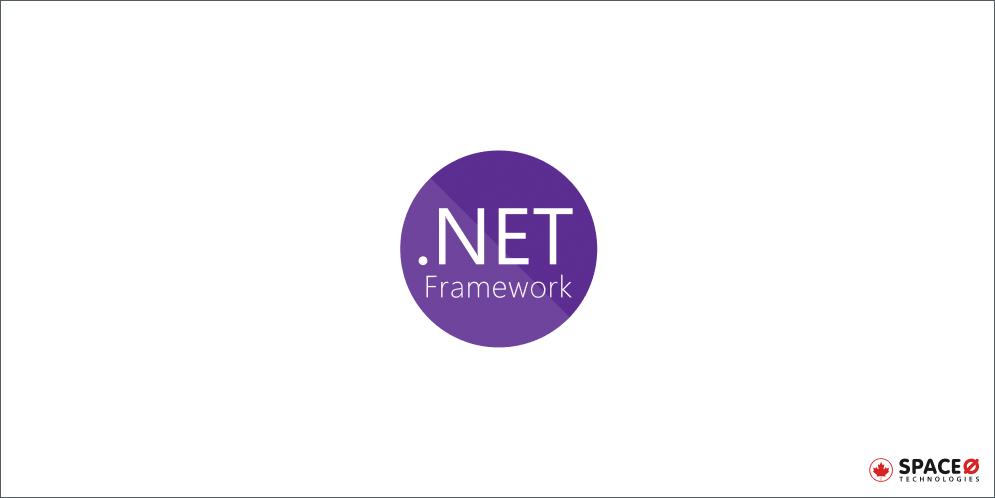
- ASP.NET is Microsoft’s offering to compete against Java.
- It is a web application framework that uses languages, such as Visual Basic(VB), C#, F# to build websites.
- It uses C# which is a high-level computer language. It allows developers to write programs that are not dependent on the type of computer.
- Visual Basic or VB uses GUI(graphical user interface) to modify code written in the BASIC programming language.
- It is excellent for beginners as it is easy to learn and understand.
- Using .NET you can work with a large amount of data, build web applications and mobile games.
- Some of the most popular companies that use .NET are Stack Overflow, Microsoft, and Starbucks.
Ruby
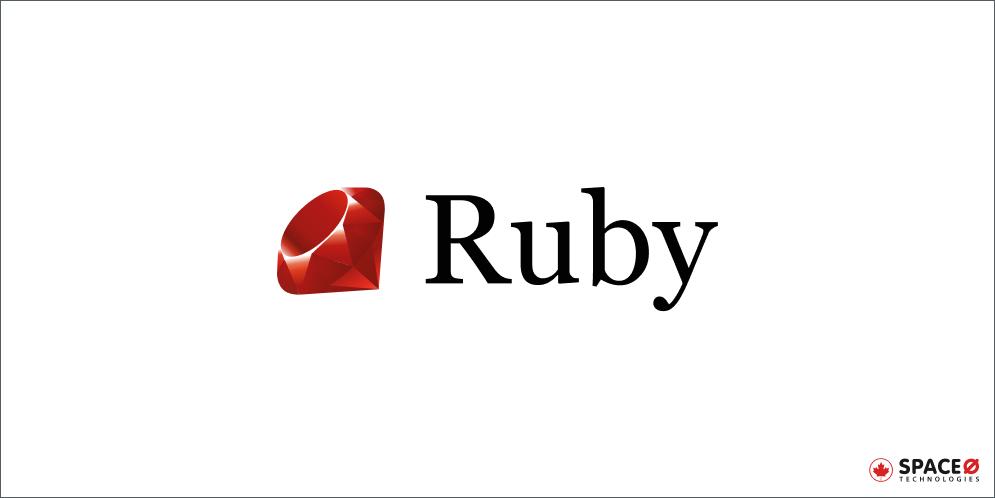
- Ruby on Rails or Ruby is a web development language built on top of the Ruby programming language and has many similarities with Python.
- It is also a dynamic, open-source object-oriented programming language.
- It has simple back end development tools that allow you to create basic tasks.
- With little backend work, Ruby enables back end developers to quickly create and launch services.
- With Ruby, you can easily create prototypes and automate repetitive tasks.
- Some of the most popular companies that use Ruby are Airbnb, AngelList, and Scribd.
SQL
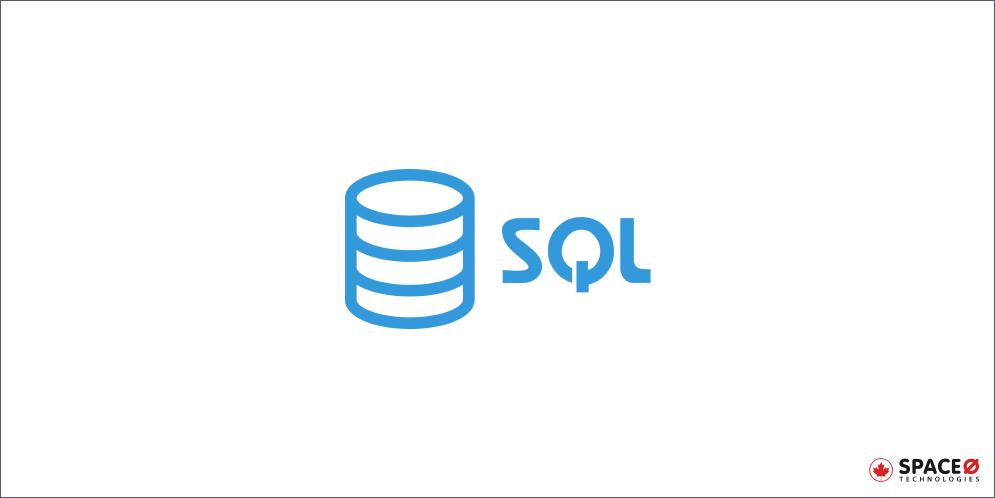
- SQL stands for Structured Query Language, and it is pronounced as ‘sequel’.
- It is one of the most common query languages used to interact with databases.
- It is a declarative language and is great for beginners.
- SQL can access, manipulate, and create databases.
- Because SQL is a query language, any company that has a database is most probably using it.
JavaScript
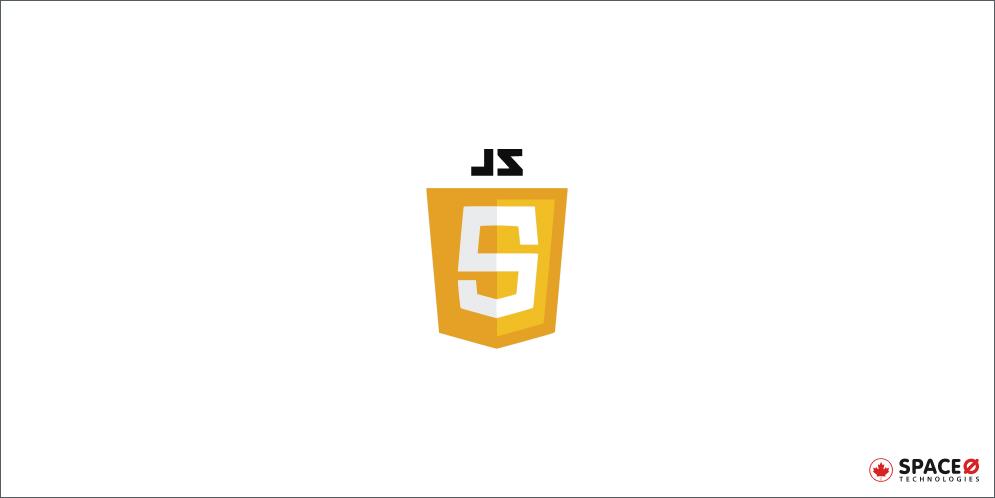
- JavaScript is different from Java, and it can be used by both a front-end web developer and back-end developers.
- It is also great for beginner front end developers and back end developers as there is little to no setup needed.
- Back end developers and front end developers can even use it with the browser.
- JavaScript is also a well-known language among full stack developers.
- The community is large, and that means you can always get support.
- JavaScript can be used to make websites, mobile apps, games, web servers, and a lot more.
- Some of the most popular companies that use JavaScript are eBay, Square, and Asana.
Skill Set Required to Become A Backend Developer
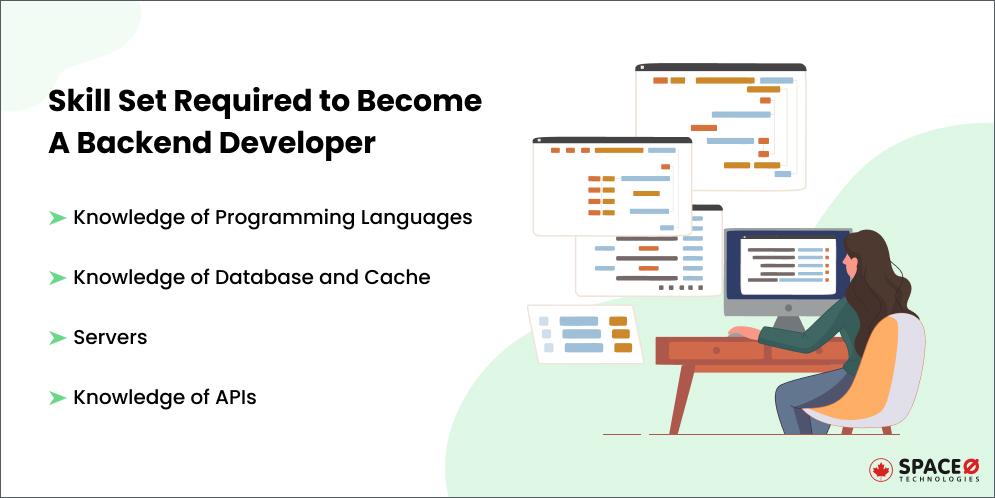
Just like with every other thing, to become a good back-end web developer you must acquire some skills that will help you in the field of back-end web development.
Below we have mentioned some of the backend web developer skills–
Knowledge of Programming Languages
We have already discussed essential coding languages for backend development. Now, this field is more technical than creative. So unlike front end development where your creative thinking also plays a part in designing, back end development requires a lot of coding and technical knowledge of multiple programming languages.
Good command of multiple coding languages, such as Java, Python, .NET will help you in full-stack development. But if not that, it is recommended to learn at least one good server-side programming language.
Knowledge of Database and Cache
Knowledge of various DBMS(Database Management System) is another important skill for a backend developer. MySQL, MongoDB, Oracle, SQLServer, Redis are some of the most popular DBMS.
Along with Database management knowledge, it is important to have a decent knowledge of caching mechanisms like varnish, Memcached, and Redis. Caching mechanisms help in making a website/application faster. This is one of the most important back end developer skills.
Servers
Server-related processes also fall under the scope of back-end developers. If you have a background in Linux, that adds up like a charm, and you can administer servers quite easily. You should also learn to handle servers like Apache, Ngnix, IIS servers, Microsoft IIS.
Knowledge of APIs
We have already discussed the importance of APIs. For full-stack developers, knowledge of APIs or web services is important. Along with that, a full stack developer can also learn about the creations and consumption of SOAP and REST.
Looking to Hire Dedicated Back-end Web Developers?
Let’s talk. We have a team of back-end developers who have experience with Python, Ruby, Node.js, and Java.
Tips To Note
- Skills to Work with Frameworks like Django for Python, Larval for PHP, and learn how to use frameworks to your advantage
- Learn to write good unit tests
- For any back-end developer or full-stack developer to learn about Data Structures and Algorithms
- Keep in mind all the security concerns as every layer has its weaknesses
- Have basic knowledge of front-end development languages like HTML (HyperText Markup Language) and CSS
- Good knowledge to optimize the site for platforms as mobile and desktop come in handy
- Have good knowledge of session management in a distributed server environment
Roles and Responsibilities of a Backend Developer
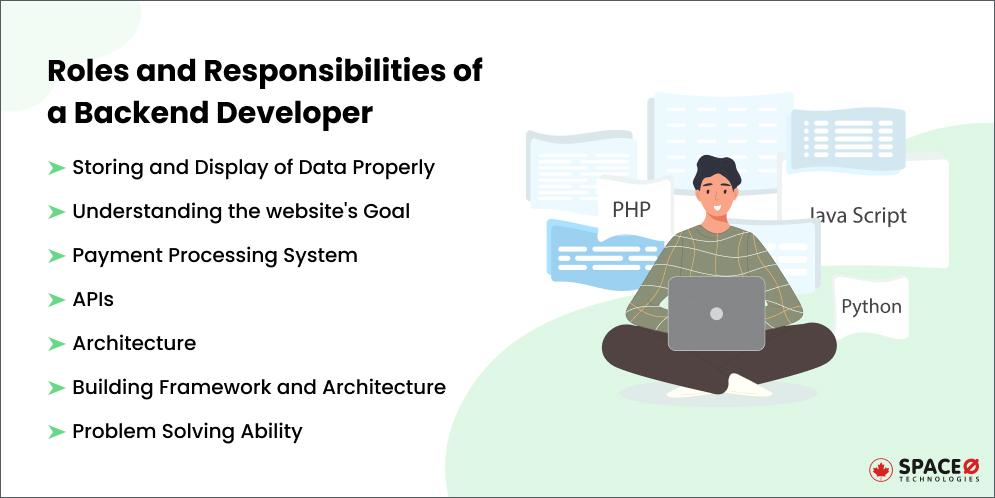
Let’s check here back end developer roles and responsibilities:
- Storing and Display of Data Properly – You will have to make sure that the data is stored securely and effectively. You will also have to take care that the data is displayed to the people who have access to it.
- Understanding the website’s Goal – It is the back-end developer’s responsibility to understand the website’s goals and develop strategies that help attain them.
- Payment Processing System – As a backend developer, it will be your responsibility to make a Payment Processing System that accepts and store the data securely and make payments.
- API – You will manage resources that can work on multiple devices.
- Architecture – You might also be involved in the architecture of a system and Data Science analysis.
- Building Framework and Architecture – You will have to build architecture or frameworks for easy programming.
- Problem Solving Ability: As a backend developer, you should implement proper solutions to the problems related to the system and algorithms.
Front-End Developer vs Back-End Developer
| Comparison | Front-End Developer | Back-End Developer |
|---|---|---|
| Skill Required | Good command of scripting languages like HTML, CSS, JavaScript |
|
| Role | To design the graphical interface of a website | Develop an application that supports the front-end and gives security, support, and content management |
| Goal |
|
|
| Most Popular Tools/ Languages Used | HTML, JQuery, CSS, JavaScript | MySQL, PHP, Java |
| Average Salary in USD | USD 104,405 per annum | USD 120,798 per annum |
Still have some queries or questions? Check the following FAQs section.
FAQ About Backend Development
What is meant by Backend Developer?
A back-end developer is responsible for the server-side processes of a website.
What are Backend Technologies?
The technologies that handle the backend side of a website like a server, applications, and database. This could include languages like .NET, PHP, and Java.
What is Backend App Development?
It is the development of an application that handles all the backend processes of an app.
What are the Languages Used for Backend Development?
Java, PHP, Python, .NET, Ruby, SQL, JavaScript are some of the languages that are used for back-end development.
What is the Difference Between Front-End and Back-End Development?
Front-End development is all about creating a smooth attractive interface for a website. Back-end development is developing an application that supports the front-end and provides security, support, and content management.
Is Python Frontend or Backend Language?
Python uses for both front-end and back-end development. However, it has very good implementations in backend development.
How to become a back end developer?
To become a back end developer, you require to have an understanding of the following concepts.
- Basics of data structures & algorithm
- Knowledge of a backend programming language
- Basics of databases
- Learn the framework for developing backend
- Understanding of hosting services
- Know how to deploy the app on hosting servers
Apart from the above basis, you would require to start practicing backend development by working on small projects.
Conclusion
So that was all about Back-end development. We discussed all the essential points related to back-end development, including important languages used in back-end development, the tools and technologies, and how one can become a good back-end developer and the differences between a front-end and a back-end developer.
Being an entrepreneur, if you are looking for the professional back-end programmer, who has hands-on experience in delivering advanced quality backend development services, then we, at Space-O Canada, has a team of backend developers to suffice your needs.
If you have any queries or questions, get in touch with us through our contact us form and one of our representatives will get back to you shortly. To get such informative blog posts directly into your inbox, subscribe to our newsletter today!
All our projects are secured by NDA
100% Secure. Zero Spam
*All your data will remain strictly confidential.
Trusted by


Bashar Anabtawi
Canada
“I was mostly happy with the high level of experience and professionalism of the various teams that worked on my project. Not only they clearly understood my exact technical requirements but even suggested better ways in doing them. The Communication tools that were used were excellent and easy. And finally and most importantly, the interaction, follow up and support from the top management was great. Space-O not delivered a high quality product but exceeded my expectations! I would definitely hire them again for future jobs!”

Canada Office
2 County Court Blvd., Suite 400,
Brampton, Ontario L6W 3W8
Phone: +1 (437) 488-7337
Email: sales@spaceo.ca

